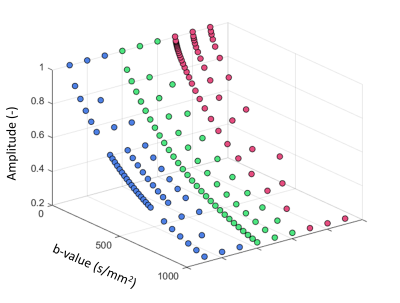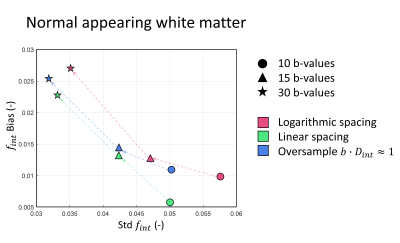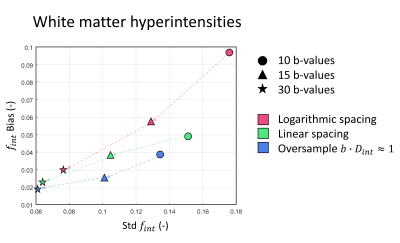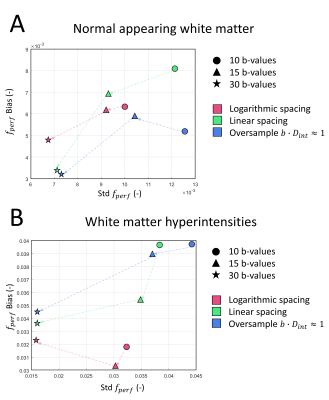2393
Evaluation of different b-value sampling strategies in cerebral IVIM: application to interstitial fluid1Maastricht University Medical Center, Maastricht, Netherlands
Synopsis
Recently, it was shown that besides the parenchymal diffusion and microvascular perfusion an additional, intermediate, component can be observed in the IVIM signal. The fraction of this intermediate diffusion ($$$f_{int}$$$) is suggested to be related to interstitial fluid in the perivascular spaces (PVS). In this study we examine several b-value sampling strategies for measuring the ($$$f_{int}$$$) using simulated IVIM data. When a large intermediate diffusion component is present in the IVIM signal (eg. white matter hyperintensities), b-value sampling strategies specifically aimed to quantify this component can provide better estimates of $$$f_{int}$$$ compared to linear or logarithmic spaced b-values.
Introduction
Intravoxel Incoherent Motion (IVIM) MR imaging is a diffusion weighted imaging technique that is sensitive to the diffusion of water in the parenchyma as well as flow-mediated diffusivity of microvascular blood (perfusion). Commonly, the fraction of microvascular perfusion in the IVIM signal $$$f_{perf}$$$ is calculated using a bi-exponential model. Recently, however, it was shown that besides the parenchymal diffusion and microvascular perfusion an additional, intermediate, component can be observed [1]. The fraction of the intermediate diffusion is suggested to be related to interstitial fluid in the perivascular spaces (PVS). PVS are associated with a number of disorder, ranging from Alzheimer’s disease, stroke and multiple sclerosis [2]. Therefore, estimating $$$f_{int}$$$ from IVIM data can provide valuable clinical insights. However, estimating $$$f_{int}$$$ can be challenging, since three-component models and spectral decompositions of the IVIM signal are dependent on the acquired b-values and signal-to-noise ratio (SNR). Therefore, in this study we will examine several b-value sampling strategies for measuring the $$$f_{int}$$$ using simulated IVIM data.Methods
Numerical simulationsGround-truth IVIM data with three components were computationally synthesized using the IVIM signal decay equation:
$$\frac{S(b)}{S(0)}=\frac{f_{par}E_{1,par}E_{2,par}e^{-bD_{par}}+f_{int}E_{1,int}E_{2,int}e^{-bD_{int}}+f_{perf}E_{1,perf}E_{2,perf}e^{-bD_{perf}}}{f_{par}E_{1,par}E_{2,par}+f_{int}E_{1,int}E_{2,int}+f_{perf}E_{1,perf}E_{2,perf}}$$
Where, $$$E_{1,k}=(1-2e^{-\frac{TI}{T_{1,k}}}+e^{-\frac{TR}{T_{1,k}}})$$$, with $$$k=par$$$ or $$$int$$$; $$$E_{1,perf}=(1-e^{-\frac{TR}{T_{1,perf}}})$$$; $$$E_{2,k}=e^{-\frac{TE}{T_{2,k}}}$$$, with $$$k=par$$$, $$$int$$$ or $$$perf$$$; and $$$f_{par}=1-f_{int}-f_{perf}$$$.
The IVIM parameters used to simulate the signal decay were $$$f_{int}= .050$$$; $$$f_{perf}=.022$$$; $$$D_{par}=7.15\cdot10^{-4}$$$mm2/s; $$$D_{int}=2.4\cdot10^{-3}$$$mm2/s and $$$D_{perf}=1.63\cdot10^{-2}$$$mm2/s; corresponding to normal appearing white matter (NAWM). Additionally, data with high $$$f_{int}$$$ were synthesized simulating white matter hyperintensities (WMHs) using $$$f_{int}= .271$$$; $$$f_{perf}= .024$$$; $$$D_{par}=8.93\cdot10^{-4}$$$mm2/s; $$$D_{int}=2.0\cdot10^{-3}$$$mm2/s and $$$D_{perf}=7.85\cdot10^{-2}$$$mm2/s [1][3]. The following relaxation times were used; $$$T_{1,par}=1081$$$ms, $$$T_{2,par}=95$$$ms, $$$T_{1,pef}=1624$$$ms, $$$T_{2,perf}=275$$$ms, $$$T_{1,int}=1250$$$ms, $$$T_{2,int}=1500$$$ms [1][4-7].
To estimate the effects of acquired b-values on the quantification of $$$f_{int}$$$, 1000 Gaussian noise realizations were calculated for nine sets of b-values and an SNR of 100 (defined as the signal at b = 0s/mm2 divided by the standard deviation of the noise). Each of the b-values sets that are considered range from 0 to 1000s/mm2. Three sets were linearly spaced, three were logarithmically spaced, and three had an oversampling in the range of 300<b<600s/mm2 where $$$b\cdot D_{int}\approx1$$$. The number of b-values is varied for each sampling strategy (10, 15 and 30). Figure 1 graphically depicts the nine schemes with different b-values.
Fitting method
The NNLS uses a predefined basis set A with M exponential decays to characterize the measured signal $$$y$$$ as; $$$y_i=\sum_j^Ms_je^{-b_iD_j}=\sum_j^M \mathbf{A}_{ij}s_j,i=1,2,..,N$$$ where $$$s_j$$$ is the amplitude corresponding to the $$$D_j$$$ diffusivity, $$$b_i$$$ is the measured signal of b-value $$$i$$$ and $$$N$$$ represents the total number of b-values. Now, the NNLS problem can be written as, $$$\chi_{min}^2=\min_{s \geq 0}(\sum_{i=1}^N\mid\sum_{j=1}^M\mathbf{A}_{ij}s_j-y_i\mid^2)$$$ where $$$\chi_{min}^2$$$ represents the misfit that is minimized by the NNLS algorithm. Typically, the number of b-values is smaller than the elements in the basis set (N<M) making the NNLS an ill-posed problem. To provide a more stable solution, a regularized version of the NNLS can be used, adding a smoothing constraint, $$$\chi_{reg}^2=\min_{s \geq 0}(\sum_{i=1}^N\mid\sum_{j=1}^M\mathbf{A}_{ij}s_j-y_i\mid^2+\mu\sum_{j=1}^M\mid s_{j+2}-2s_{j+1}+s_j\mid^2)$$$ where $$$\mu$$$ is the regularization parameter and $$$\chi_{reg}^2$$$ is the regularized misfit [8].
A basis set with 120 logarithmically spaced elements ranging from 0.1$$$\cdot$$$10-3 to 1000$$$\cdot$$$10-3 is used. Subsequently, the $$$f_{int}$$$ is defined as the amplitude fraction of the $$$D_j$$$ elements in the range of 1.5$$$\cdot$$$10-3 to 4.0$$$\cdot$$$10-3. The $$$f_{int}$$$ is corrected for the effects of inversion and relaxation [1].
Validation
The accuracy of the different strategies was evaluated using the bias, $$$\hat{f_{int}}-f_{int}$$$, where $$$\hat{f_{int}}$$$ is the mean estimated intermediate fraction, and $$$f_{int}$$$ is the ground-truth intermediate fraction.
The precision of the different strategies was evaluated by the standard deviation of the estimated intermediate fraction.
Results
The accuracy and precision of the $$$f_{int}$$$ estimation in terms of bias and standard deviation is shown in figure 2 for the NAWM and in figure 3 for the WMHs. For the NAWM a linear spacing of the b-values seems to provide the best trade-off between accuracy and precision. However, for the WMHs, where a large $$$f_{int}$$$ is present, oversampling the $$$b\cdot D_{int}\approx1$$$ range provides the highest accuracy and precision.Discussion & Conclusion
Interestingly, acquiring more b-values does not appear to be valuable in the NAWM, as the accuracy drops, while in the WMHs acquiring more b-values does relate to better performance. This can be explained; when simulating data with 10 b-values, for roughly 14% of the noise realizations no third component is found, artificially lowering the measured $$$f_{int}$$$. The third component is absent in 6% of the realizations with 15 b-values, and in less than 1% in the 30 b-values case. This effect, combined with a systematic over-estimation of the $$$f_{int}$$$, results in the presented behavior. Over-estimation of the intermediate fraction can be contributed to an under-estimation of the $$$D_{par}$$$ and $$$f_{par}$$$, which is a known phenomenon related to the logarithmic distribution of the basis set [9].When a large intermediate diffusion component is present in the IVIM signal (e.g. in WMHs), b-value sampling strategies specifically aimed to quantify this component can provide a better estimate of $$$f_{int}$$$ compared to linearly or logarithmically spaced b-values. However, studies interested in measuring $$$f_{perf}$$$ benefit more from logarithmically spaced b-values (which oversamples $$$b\cdot D_{perf}\approx1$$$ range), while a linearly spaced b-value set provides a good trade-off between $$$f_{int}$$$ and $$$f_{perf}$$$ (Figure 4A&B).
Acknowledgements
No acknowledgement found.References
[1] Wong SM, Backes WH, Drenthen GS, et al., Spectral diffusion analysis of interavoxel incoherent motion MR imaging in cerebral small vessel disease. J. Magn. Reson. Imaging 2020;51:1170–1180.
[2] Wardlaw JM, Benveniste H, Nedergaard M, et al., Perivascular spaces in the brain: anatomy, physiology and pathology. Nat Rev Neurol 2020;16:137–153.
[3] Wong SM, Zhang CE, van Bussel FCG, et al., Simultaneous investigation of microvasculature and parenchyma in cerebral small vessel disease using intravoxel incoherent motion imaging. NeuroImage: Clinical, 2017; 14:216-221.
[4] Simon JE, Czechowasky DK, Hill MD, et al., Fluid-attenuated inversion recovery preparation: Not an improvement over conventional diffusion-weighted imaging at 3T in acute ischemic stroke. AM J Neuroradiol 2004;25:1653-1658
[5] Lu HL, Clingman C, Golay X and van Zijl PCM, Determining the longitudinal relaxation time (T1) of blood at 3.0 Tesla. Magn Reson Imaging 2004; 52:679-682.
[6] Wansapura JP, Holland SK, Dunn RS and Ball WS, NMR relaxation times in the human brain at 3.0 tesla. J Magn Reson Imaging 1999; 9:531-538.
[7] Stanisz GJ, Odrobina EE, Pun J, et al., T1, T2 relaxation and magnetization transfer in tissue at 3T. Magn Reson Med 2005; 54:507-512.
[8] Whittall KP, MacKay AL. Quantitative interpretation of NMR relaxation data. J Magn Reson. 1989; 84:134-152.
[9] Drenthen GS, Backes WH, Aldenkamp AP, et al. A new analysis approach for T2 relaxometry myelin water quantificiation: Orthogonal Matching Pursuit. Magn Reson Med 2019; 81:3292-3303.
Figures



